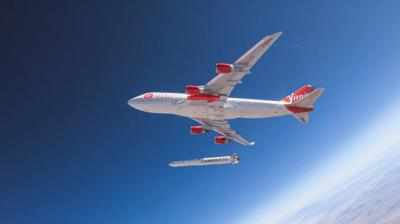String of Successful Launches Broken
Founded in 2017 to provide launch services for small satellites, Virgin Orbit is a subsidiary of ultra-hip British billionaire, entrepreneur, commercial astronaut, and business magnate Sir Richard Branson’s Virgin Group. The company’s principal offering is its LauncherOne rocket, an air-launched, two-stage orbital launch vehicle designed to carry smallsat payloads of up to 660-pounds (300-kilograms) into Sun-synchronous orbit (SSO) following air launch from a Boeing 747 carrier aircraft dubbed Cosmic Girl.
The term smallsat is a neologism denoting satellites of low mass and volume, usually under 600-pounds (300-kilograms).

LauncherOne attained orbit for the first time on 17 January 2021, successfully deploying ten cubesat satellites.
The company claims approximately $300-million in active contracts, and projects its rocket launch business will grow to some 18 launches in 2023, and aspires to reach revenues of $2.1-billion by 2026.
On 09 January 2023, during the vehicle’s first attempted orbital launch from the United Kingdom, LauncherOne experienced an anomaly, leading to a premature shutdown of the rocket’s second-stage engine and failure to attain orbit.
Within hours of the mission’s conclusion, Virgin Orbit—under the auspices of aerospace veteran Jim Sponnick and company chief engineer Chad Foerster—commenced investigating the failure. Oversight of the investigation is the shared province of the U.S. Federal Aviation Administration and the U.K. Air Accidents Investigation Branch. Personnel of the U.S. Department of Defense (DOD), National Transportation Safety Board (NTSB), National Reconnaissance Office (NRO), and the U.K. Civil Aviation Authority will also take part in the investigative process.
For purpose of ensuring the investigation is conducted with the utmost rigor, the investigative team is utilizing a comprehensive fault tree, a hyper-detailed timeline, and additional, similarly pedantic means and products.

Investigators have confirmed thus far that Virgin Orbit’s team correctly and successfully executed pre-flight preparations, carrier aircraft takeoff, captive carry flight, and rocket release. The LauncherOne vehicle’s ignition, first-stage flight, stage separation, second-stage ignition, and fairing deployment were all nominal.
Investigators have further observed and determined:
- Data from the beginning of the second stage first burn indicates a fuel filter within the fuel feedline may have been dislodged from its normal position.
- Additional data indicates a fuel pump downstream of the aforementioned filter operated at a degraded efficiency level, resulting in fuel-starvation of the rocket’s Newton 4 engine. Performing anomalously in the absence of cooling fuel, subject engine exceeded its design temperature rating.
- Components adjacent to and in the vicinity of the atypically hot engine malfunctioned, thereby causing premature termination of the rocket’s second stage thrust.
- Early thrust termination precluded the launch vehicle’s continued ascent. Deprived of thrust, the rocket’s second stage and payload fell to Earth, landing in the mission’s approved Atlantic Ocean safety corridor.
At present, investigators are formulating analyses, and devising and performing tests by which to replicate flight conditions in hopes of determining the failure’s root cause or causes.
Virgin Orbit CEO Dan Hart stated: “In space launch, a failure is painful for all involved. Intense disappointment gets quickly channeled into the motivation to dig into the cause, to understand all contributing elements and to thereby get back to flight with a better system and a wiser team. Our investigation is not yet complete; the team is hard at work and we’ll pursue the cause and contributors to wherever the system analysis takes us. However, with many clear clues from extensive data assessment now understood, we are modifying our next rocket with a more robust filter and we are looking broadly to assure that all credible contributors to mission failure are rooted out and addressed. With those modifications being incorporated on our factory floor, we will proceed cautiously toward the launch of our next rocket, which is well into the integration and test process.”
Prior to the U.K. mishap, LauncherOne performed to specifications over the entirety of four operational flights, accurately delivering 33 payloads to their required orbits.
Virgin Orbit’s next mission is slated to launch from California’s Mojave Air and Space Port. The company will make public additional details germane to that endeavor in the coming weeks.
 ANN's Daily Aero-Term (04.25.24): Airport Rotating Beacon
ANN's Daily Aero-Term (04.25.24): Airport Rotating Beacon ANN's Daily Aero-Linx (04.25.24)
ANN's Daily Aero-Linx (04.25.24) Klyde Morris (04.22.24)
Klyde Morris (04.22.24) Airborne 04.24.24: INTEGRAL E, Elixir USA, M700 RVSM
Airborne 04.24.24: INTEGRAL E, Elixir USA, M700 RVSM Airborne 04.22.24: Rotor X Worsens, Airport Fees 4 FNB?, USMC Drone Pilot
Airborne 04.22.24: Rotor X Worsens, Airport Fees 4 FNB?, USMC Drone Pilot




